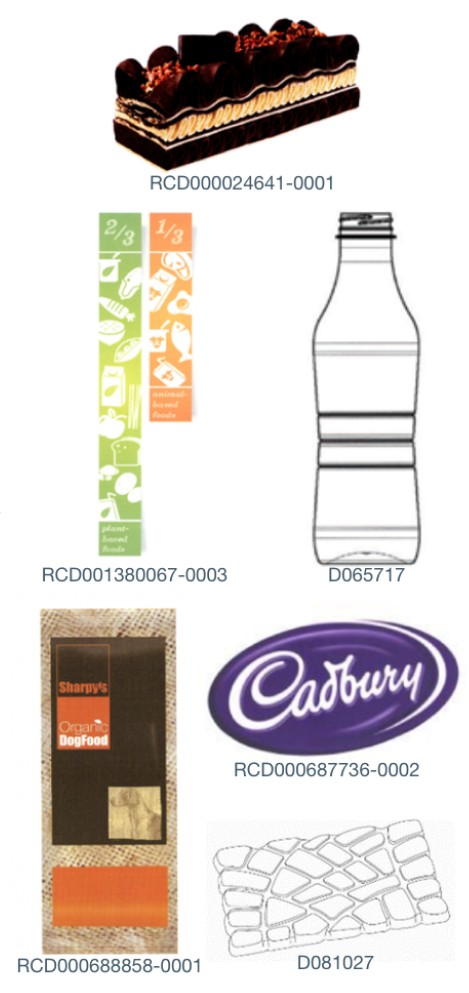Registered designs are an often over-looked but relatively inexpensive form of intellectual property. In this article, we provide an overview of what might be protectable by registered designs in the food and drink industry, as well as how such designs can be protected and why this may be useful.
What can be protected?
Registered designs effectively protect new and distinctive visual aspects (including shape, colour, texture and material) of a product.
They may protect three-dimensional products and packaging as well as two-dimensional images, such as labels, logos and other graphical features.
Some example registrations from the food and drinks industry can be seen in this article and include the following:
- The shape, colour, texture and material of a cake (RCD000024641-0001)
- The colour, graphics and two-dimensional design of a label (RCD001380067-0003)
- The shape of a bottle (D065717)
- The colour and two-dimensional design of a logo (RCD000687736-0002)
- The colour, graphics and two-dimensional layout of the front of a package (RCD000688858-0001)
- The shape of a chocolate bar (D081027)
How is registered design protection obtained?
An application for a registered design contains one or more views of the design for which protection is sought.
Black and white drawings are recommended to protect shapes alone, thereby covering any colour, texture or material variants. However, it can be useful to include such features, for example, when they contribute to the distinctiveness of the design.
In the UK and EU it is possible to include multiple related designs in a so-called multiple design application. This is a cost-effective option for covering design variants for minimal additional cost.
Although a brief description of the product can be included, it is not required in the UK or EU, as the protection is based solely on the submitted figures.
National (e.g. UK, US etc.), regional (e.g. EU) and international design protection can be applied for.
The international design system is based on the Hague Agreement for Industrial Designs and currently includes 77 member states. Whilst membership by key countries is gradually increasing with the likes of Japan, China and the USA joining in recent years, there is still a lack of harmonisation in what can be protected and how it should be shown in different jurisdictions and therefore the use of the international design system may not provide optimal protection in each designated state. As such we generally recommend filing national or regional applications in key markets.
As there is no substantive examination of registered design applications in the UK and EU, most applications proceed to registration within a matter of days or weeks, with minimal cost being incurred after filing the application.
Why should registered design protection be considered?
Owners of registered designs have an exclusive right to use the design and any design which does not produce a different overall impression on an informed user. Accordingly, they can be used to prevent others from using the same designs or similar designs.
Interestingly, the scope of protection of a registered design is not limited by the title of the product. Consequently, design protection for the chocolate bar depicted in D081027 would cover any product that has the same (or at least a very similar) shape as that depicted in the figures.
In the UK and EU, initial protection lasts for 5 years and this can be extended for further 5 year periods to provide a total of up to 25 years of protection.
Comparison with other rights
In some territories, such as the UK and EU, unregistered design protection may arise automatically (in a manner akin to copyright) when a new design is created. However, such unregistered design rights are generally short-lived and infringement requires proof that actual copying of the design (as opposed to independent conception) has taken place.
Registered designs may only protect the look of a product or graphic and not its function or method of manufacture, which may be protected by patents. Moreover, unlike for patents, a 12 month grace period is provided in the UK and EU (but not worldwide) in which the disclosure of a new design before a registered design application is filed, will not be immediately fatal to the validity of the resulting registered design.
Although there is an overlap with trade mark protection in terms of what can be protected by registered designs (e.g. for the case of logos and shape marks), one form of intellectual property should not be deemed to be a substitute for the other because there are significant differences in what is actually being protected in each case. For example, registered designs protect any products that look like the item depicted, whereas trade mark protection is generally limited by the classes of goods and services applied for.
In addition, a trade mark serves as a badge of origin giving consumers confidence as to who is responsible for the product in question. This leads to a higher bar for obtaining valid trade mark protection when compared to registered design protection and therefore it may be possible to protect a logo that is refused for trade mark protection with a registered design.
In light of the above, we recommend that registered design protection be considered as an additional IP right to supplement the rights afforded by trade mark and patent protection, particularly where visual aspects of a product or graphic are important to your business.



